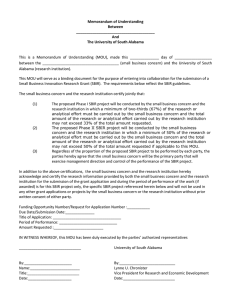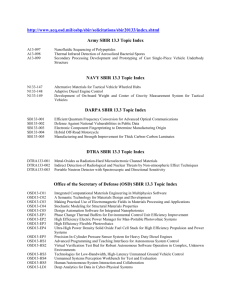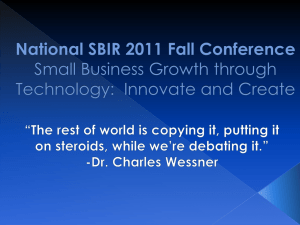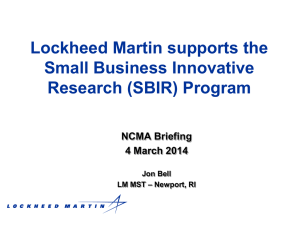TESTIMONY 6
advertisement
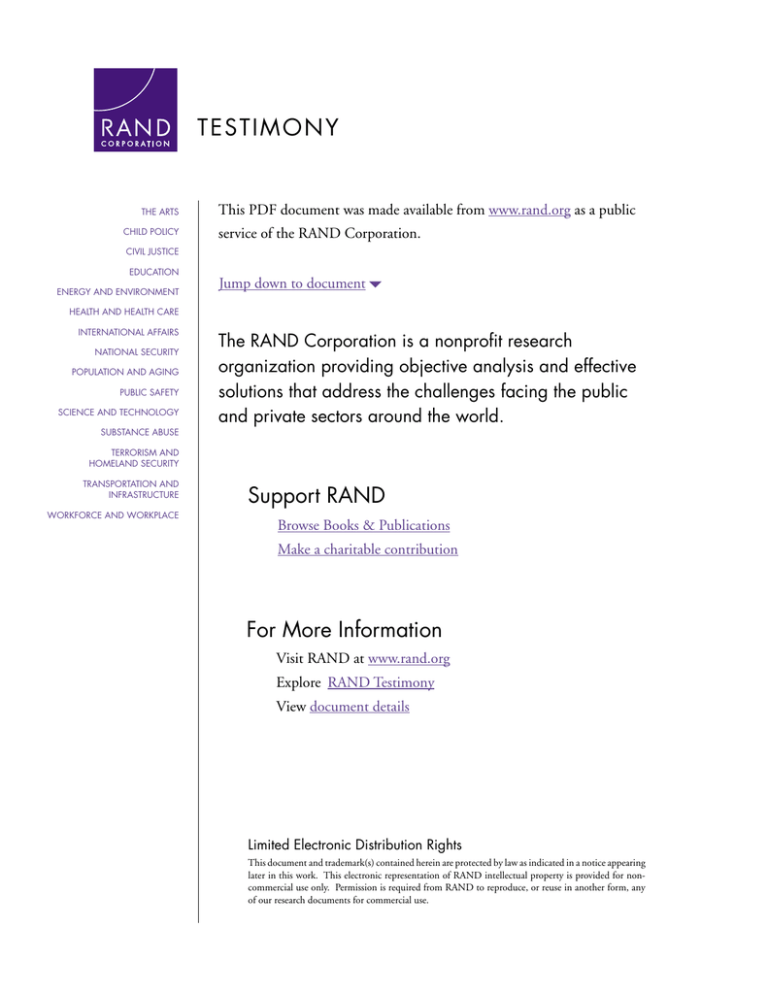
TESTIMONY THE ARTS CHILD POLICY This PDF document was made available from www.rand.org as a public service of the RAND Corporation. CIVIL JUSTICE EDUCATION ENERGY AND ENVIRONMENT Jump down to document6 HEALTH AND HEALTH CARE INTERNATIONAL AFFAIRS NATIONAL SECURITY POPULATION AND AGING PUBLIC SAFETY SCIENCE AND TECHNOLOGY SUBSTANCE ABUSE The RAND Corporation is a nonprofit research organization providing objective analysis and effective solutions that address the challenges facing the public and private sectors around the world. TERRORISM AND HOMELAND SECURITY TRANSPORTATION AND INFRASTRUCTURE WORKFORCE AND WORKPLACE Support RAND Browse Books & Publications Make a charitable contribution For More Information Visit RAND at www.rand.org Explore RAND Testimony View document details Limited Electronic Distribution Rights This document and trademark(s) contained herein are protected by law as indicated in a notice appearing later in this work. This electronic representation of RAND intellectual property is provided for noncommercial use only. Permission is required from RAND to reproduce, or reuse in another form, any of our research documents for commercial use. TESTIMONY Improving the Department of Defense’s Small Business Innovation Research Program BRUCE HELD CT-280 April 2007 Testimony presented before the House Science and Technology Committee, Subcommittee on Technology and Innovation on April 26, 2007 This product is part of the RAND Corporation testimony series. RAND testimonies record testimony presented by RAND associates to federal, state, or local legislative committees; government-appointed commissions and panels; and private review and oversight bodies. The RAND Corporation is a nonprofit research organization providing objective analysis and effective solutions that address the challenges facing the public and private sectors around the world. RAND’s publications do not necessarily reflect the opinions of its research clients and sponsors. is a registered trademark. Published 2007 by the RAND Corporation 1776 Main Street, P.O. Box 2138, Santa Monica, CA 90407-2138 1200 South Hayes Street, Arlington, VA 22202-5050 4570 Fifth Avenue, Suite 600, Pittsburgh, PA 15213 RAND URL: http://www.rand.org/ To order RAND documents or to obtain additional information, contact Distribution Services: Telephone: (310) 451-7002; Fax: (310) 451-6915; Email: order@rand.org Statement of Bruce Held1 Senior Policy Researcher The RAND Corporation Improving the Department of Defense’s Small Business Innovation Research Program2 Before the Committee on Science and Technology Subcommittee on Technology and Innovation United States House of Representatives April 26, 2007 Mr. Chairman and members of the Subcommittee, thank you for the invitation to testify before you today. My testimony today draws primarily on research that I led in 2004 for the Department of Defense’s Small Business Technology and Industrial Base Office (SBTIBO).3 The purpose of that research was to provide DoD with insights into the current status of its Small Business Innovation Research (SBIR) program in terms of the department’s transformational technology priorities, innovation, and the small-business defense industrial base. Following that initial assessment, the project’s objective became the recommendation of policy options for making the DoD SBIR program more responsive to the needs of the department.4 While my testimony draws on this work, today I speak as an individual. In my invitation to testify today I was asked to address the following questions: 1. How could program effectiveness be improved? What are appropriate award levels? How should administration costs be funded? 2. How can the programs increase the participation of innovative small businesses in federal R&D? 3. What program enhancements do you recommend to address financing and commercialization assistance needs of participants? 1 The opinions and conclusions expressed in this testimony are the author’s alone and should not be interpreted as representing those of RAND or any of the sponsors of its research. This product is part of the RAND Corporation testimony series. RAND testimonies record testimony presented by RAND associates to federal, state, or local legislative committees; government-appointed commissions and panels; and private review and oversight bodies. The RAND Corporation is a nonprofit research organization providing objective analysis and effective solutions that address the challenges facing the public and private sectors around the world. RAND’s publications do not necessarily reflect the opinions of its research clients and sponsors. 2 This testimony is available for free download at http://www.rand.org/pubs/testimonies/CT280. 3 Now in the DoD’s Office of Small Business Programs. 4 Held, Bruce, Thomas Edison, Shari Lawrence Pfleeger, Philip S. Anton, John Clancy, Evaluation and Recommendations for Improvement of the Department of Defense Small Business Innovation Research Program (SBIR), Santa Monica, CA: RAND, DB-490-OSD, 2006. 1 Assessing the Current DoD SBIR Program The DoD’s SBIR program appears to be accomplishing the broad goals set out in the program’s enabling legislation. The program’s resources stimulate innovation by funding R&D contracts with small businesses and, in fact, the DoD SBIR program attracts a large number of small businesses to the DoD R&D market; roughly 250 to 400 new contractors each year. The DoD SBIR program also provides opportunity for minority- and women-owned small businesses to contract with DoD, although it is not as effective as other DoD R&D programs that specifically target these companies. Finally, some commercialization of DoD R&D appears to be linked to the SBIR program. However, the limited information available indicates that commercialization as a result of SBIR-funded research is concentrated in just a few companies.5 The effectiveness of the program in generating technology, products, services and process that are utilized by the armed forces is less clear.6 As a result, the DoD may not be taking the best advantage of the research results that emerge from its SBIR program, and the small-business participants may not be getting the commercialization opportunities that would turn their innovations into sales or other sources of revenue. There appear to be two primary reasons that the DoD SBIR program has had difficulty transitioning research results. First, the leadership emphasis for the program has been on statutory compliance rather than research outcome and utilization. The result is a management orientation that is more focused on the process issues associated with executing the thousands of SBIR awards than it is with utilizing the results of those awards. Second, most of the DoD’s SBIR program is managed out of its laboratories and research centers. Though these organizations conduct and manage important research for the DoD, that work tends to be earlier stage research that requires a long and difficult development and transition cycle before being incorporated into the equipment or processes used by the armed forces. How SBIR research results are managed through this transition process is opaque at best. For the SBIR small- 5 For example, in our research we examined the DoD contracting histories of small companies that first contracted with the DoD through the SBIR program. In 1995 256 companies used the SBIR program as their entrée into the DoD market and in 1999 the number was 227. Of these 483 companies, only 6 account for 95 percent of the dollar value of subsequent non-SBIR DoD contracts. Additionally, an examination of self-reported commercialization data from DoD SBIR participants indicates just 1% of the companies account for 50% of all sales traceable to an SBIR project. The same data base indicates that overall sales success from DoD SBIR projects is relatively low: the sales to SBIR investment ratio is 1.17. This compares to commercial sales to R&D investment ratios of about 25 to 1. 6 This is despite an elaborate topic selection and approval process that is designed to insure that the topics align with the DoD’s research priorities and are coordinated across the department. 2 business participants, staying with this lengthy and non-transparent process is exceptionally difficult. Improving the DoD SBIR Program Efforts and policies to improve the effectiveness of the DoD’s SBIR program should, therefore, have two related goals: 1. To move the DoD leadership’s emphasis for the program from compliance and process issues to improving research outcomes and utilization. 2. To increase the participation of the DoD’s acquisition community in managing SBIR projects. Emphasizing research outcomes and utilization by the leadership requires emphasizing SBIR program flexibility to meet the technology needs of the DoD. For example, current practice within the DoD limits solicitations for SBIR projects to only one or two per year.7 This means that if a technology requirement arises shortly after a solicitation has been published, the program will not be able to address that need for six-months or a year.8 This kind of set schedule is designed for process efficiency rather than for meeting the research needs of the DoD. More frequent solicitations will require additional effort, but are likely to be more attractive to program and technology managers who are managing development schedules. Funding of DoD SBIR projects will also need to be managed more flexibly. Funding guidelines for SBIR projects have not changed in the last fifteen years. This means that the effective size of the award has declined by a third, thus removing a significant portion of the potential research projects from the SBIR program. In order to correct this issue, guidelines for the size of SBIR awards should be increased to account for inflation. Phase I award limits should be at least $150,000 and Phase II award limits should be at least $1,125,000. In addition, flexibility to exceed these guidelines needs to continue to be maintained in the reauthorization, particularly where important DoD technology requirements could be addressed by the SBIR program, but where the 7 Across the DoD there are three solicitations per year, but most services and agencies in the DoD only participate in one or two per year. 8 This does not take into account additional time required to process the topic request for inclusion in the solicitation. Additionally, even if a technology requirement is timely addressed in a solicitation, most of the DoD’s services and agencies manage the research contracts somewhat inflexibly. Phase I contracts last six months, putting a Phase II contract in place takes several months and the Phase II contract will last about two years. 3 project size exceeds the general guidelines.9 While smaller awards mean that more awards are available, larger awards mean increased flexibility to address the DoD’s technology requirements through the SBIR program. That added flexibility has the potential to improve the probability that SBIR research outcomes will transition into products and services that the small-business participants can market to the DoD and to the broader defense industry. Currently, the administrative costs for managing the DoD SBIR program are generally borne out of the overhead of the organizations within DoD charged with SBIR program responsibility.10 As a result, the incentive for these organizations is to minimize the effort put into managing the program, contributing to the process orientation that the program exhibits. Allowing a portion of the SBIR set-aside to be used to administer the program would help alleviate this incentive problem. Perhaps more important, allowing administrative costs to be recovered from the set-aside for the program would make it more attractive to the DoD’s acquisition program managers. The DoD’s acquisition program managers contribute the majority of the DoD SBIR program’s funds because they are primarily responsible for the majority of the DoD’s R&D budget from which the set-aside is applied. As noted earlier, however, across most of DoD the SBIR program is managed by the laboratories and research centers. There are likely a number of reasons for this, including explicit policy decisions. However, the disincentive for acquisition program managers to request SBIR projects is also a factor. Program management offices are typically relatively small offices so the resources to manage additional small projects and contracts are at a premium. If resources are provided to manage these projects and contracts, then it is likely that program managers will be more inclined to request access back to some of the resources they provided to the SBIR program. Combining earmarked SBIR administrative resources with increased SBIR program flexibility in terms of solicitation timing, project duration and funding amounts, the SBIR program could be turned into a more sought after resource by DoD’s acquisition program managers. While research is currently on-going to determine the total cost of managing the DoD’s SBIR program, previous research suggests that the DoD invests fewer resources into managing its SBIR program than analogous R&D efforts. To meet expectations about commercializing SBIR 9 Under current legislation, an awarding agency may determine that a particular SBIR award merits greater funding. Such awards require only that, after the fact, a written justification be submitted along with the annual SBIR report to the SBA. This flexibility seems warranted and could even be encouraged in the reauthorization to ensure that program managers feel empowered to make such judgments. 10 The Navy is an exception. It collects, in addition to the SBIR set-aside, an amount from its R&D budget to manage the SBIR program. 4 program results, the amount allocated for managing the SBIR program should be based on an analysis of the costs associated with managing other commercial, governmental and academic R&D and commercialization efforts. The venture capital industry, for example, charges annual management fees of 2.5 to 5 percent of funds under management and also earns a significant portion of any return on investment.11 Increasing Small Business Participation in the DoD SBIR Program The suggestions already made for increasing the effectiveness of the DoD SBIR program are related to the second question I was asked to address: How can the programs increase the participation of innovative small businesses in federal R&D? As noted earlier, the DoD SBIR program has been very successful in attracting new companies to the DoD R&D market. Moreover, the DoD receives nearly six proposals for every Phase I award it makes. The question should, therefore, be more about increasing the quality of the participation rather than about the overall number of companies participating. Over the course of our research we identified four distinct business models for DoD SBIR award winners. The entrepreneurial model is generally a new business created specifically to develop an idea into some product or service. The SBIR program is a source of relatively inexpensive capital for developing these ideas. The mature business model is a business that has been around for some time and that uses the SBIR program as a source of low-cost capital for research. Related to the mature business model are other established small companies who have not previously done business with the DoD and use the SBIR program to enter that market. Finally there is the research house. These companies provide research as a service and use the SBIR to provide their services to the DoD. In all of these models, perhaps with the exception of the research house, the ultimate goal for conducting research is to develop a marketable product or service.12 In our discussions with the small-business participants, however, one theme seemed fairly constant. While these companies were successfully competing for SBIR awards, they were not successful in marketing and selling the results of their research projects to the DoD for transition into products, processes or services. These interview results reinforce the data cited earlier that any success in transitioning DoD SBIR research is concentrated in a very few companies. Improving the quality of the small business participation in the DoD SBIR program 11 Since the venture capital management fees are assessed annually on funds under management a direct comparison to SBIR overhead rates understates the VC management fee. 12 Even for the research house model, gaining additional revenue through mechanisms such as licensing fees is a goal. 5 must, therefore, mean improving the likelihood that the research these companies conduct will be marketable to the DoD’s acquisition community and will transition into equipment, services and processes used by the armed forces. Making this happen will require much greater participation by the DoD’s program managers and program executive officers in the SBIR program. If this can be made to happen, the attractiveness of the DoD SBIR program to the small-business community will be increased and greater participation and competition would result. Absent steps to increase the willingness and capability of the DoD acquisition community to participate in the SBIR program, it is unlikely that other commercialization and financing efforts will be very successful. My recommendations for SBIR program enhancements, thus, center around the two main issues I mentioned earlier. The DoD leadership must shift the process orientation of its SBIR program to one that is more outcome and utilization oriented. This requires managing the program’s flexibly to responsively address the DoD’s technology requirements, and it means resourcing the SBIR program in a way that reduces the incentives for minimizing the management effort at the expense of technology transition success. In addition, policies that require and encourage DoD’s acquisition program managers to administer SBIR projects as a resource will improve the likelihood that SBIR research results will transition into technologies, products, services and processes used by the soldiers, sailors, airmen and marines of America’s armed forces. 6

